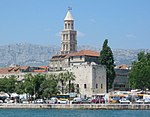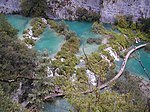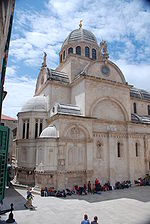This article lists the sites registered with World Heritage in Croatia.
Understand
Croatia succeeds Convention for the Protection of the World Cultural and Natural Heritage July 6, 1992. The first protected sites were inscribed in 1979.
In 2018, Croatia has 10 sites registered in the World Heritage, 8 cultural and 2 natural.
Listing
The following sites are listed as World Heritage.
| Site | Type | Criterion | Description | Drawing | |||||||||||||||||||||
|---|---|---|---|---|---|---|---|---|---|---|---|---|---|---|---|---|---|---|---|---|---|---|---|---|---|
| 1 Dubrovnik old town | Cultural | (i), (iii), (iv) |  | ||||||||||||||||||||||
| 2 Historic core of Split with Diocletian's Palace | Cultural | (ii), (iii), (iv) |  | ||||||||||||||||||||||
| 3 Plitvice National Park | Natural | (vii), (viii), (ix) |  | ||||||||||||||||||||||
| 4 Episcopal complex of the Euphrasian Basilica in the historic center of Poreč | Cultural | (ii), (iii), (iv) |  | ||||||||||||||||||||||
| 5 Historic town of Trogir | Cultural | (iii), (iv) |  | ||||||||||||||||||||||
| 6 Šibenik Cathedral | Cultural | (i), (ii), (iv) |  | ||||||||||||||||||||||
| 7 Plain of Stari Grad | Cultural | (ii), (iii), (v) |  | ||||||||||||||||||||||
Venetian defenses from the 16th century to the 17th century: Stato da Terra - Stato da Mar occidental
Other sites in Italy and at Montenegro | Cultural | (iii) (iv) | This property consists of 15 defensive structures located in Italy, Croatia and Montenegro, which are spread over more than 1000 kilometers between the Lombardy region in Italy and the eastern Adriatic coast. The fortifications of Stato da Terra, protected the Republic of Venice in the north-west and those of Stato da Mar, the maritime routes and the ports of the Adriatic Sea towards the Levant. They were necessary to support the expansion and power of the Serenissima. The introduction of gunpowder brought about significant changes in military techniques and architecture which were reflected in the design of the alla moderna (or bastioned) fortifications that would spread throughout Europe. | | |||||||||||||||||||||
Stećci medieval tomb cemeteries
Other sites in Bosnia and herzegovina, to Montenegro and in Serbia | Cultural | (iii) (vi) | This serial property brings together 28 sites, located in Bosnia and Herzegovina, western Serbia, western Montenegro, as well as central and southern Croatia, which represent medieval cemeteries and tombs, or stećci, specific to these regions. These cemeteries, which date from the 12the century to XVIe century, are organized in rows, as was the custom in Europe since the Middle Ages. The stećci are mostly carved in limestone. They feature a great diversity of decorative motifs and inscriptions which bear witness to iconographic continuities in medieval Europe and particular local traditions. | | |||||||||||||||||||||
| Primary and ancient beech forests of the Carpathians and other parts of Europe Other sites in Albania, in Germany, in Austria, in Belgium, Bulgaria, Spain, in Italy, in Poland, in Romania, in Slovakia, in Slovenia and in Ukraine | Natural | (ix) | This transnational property spans 12 countries. Since the end of the last Ice Age, European beech has spread from a few isolated refuges in the Alps, Carpathians, Dinarids, Mediterranean and Pyrenees, in the space of a few thousand years , a process that continues today. The success of the progression of beech is explained by its adaptability and tolerance to different climatic, geographic and physical conditions. | | |||||||||||||||||||||
Criteria legend
| |||||||||||||||||||||||||
